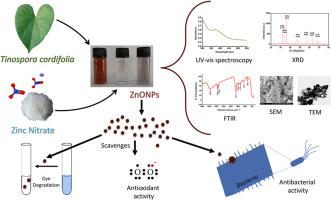当前位置:
X-MOL 学术
›
Environ. Res.
›
论文详情
Our official English website, www.x-mol.net, welcomes your feedback! (Note: you will need to create a separate account there.)
Phytosynthesis of zinc oxide nanoparticles for enhanced antioxidant, antibacterial, and photocatalytic properties: A greener approach to environmental sustainability
Environmental Research ( IF 8.3 ) Pub Date : 2024-03-20 , DOI: 10.1016/j.envres.2024.118770 C. Jayaseelan , D. Siva , C. Kamaraj , R. Thirugnanasambandam , V. Ganesh Kumar , B. Subashni , R. Ashokkumar , D. Saravanan
Environmental Research ( IF 8.3 ) Pub Date : 2024-03-20 , DOI: 10.1016/j.envres.2024.118770 C. Jayaseelan , D. Siva , C. Kamaraj , R. Thirugnanasambandam , V. Ganesh Kumar , B. Subashni , R. Ashokkumar , D. Saravanan

|
Multifunctional nanoparticles (NPs) production from phytochemicals is a sustainable process and an eco-friendly method, and this technique has a variety of uses. To accomplish this, we developed zinc oxide nanoparticles (ZnONPs) using the medicinal plant (TC). Instruments such as UV–Vis, XRD, FTIR, FE-SEM with EDX, and high-resolution TEM were applied to characterize the biosynthesized TC-ZnONPs. According to the UV–vis spectra, the synthesized TC-ZnONPs absorb at a wavelength centered at 374 nm, which corresponds to a 3.2 eV band gap. HRTEM was used to observe the morphology of the particle surface and the actual size of the nanostructures. TC-ZnONPs mostly exhibit the shapes of rectangles and triangles with a median size of 21 nm. The XRD data of the synthesized ZnONPs exhibited a number of peaks in the 2θ range, implying their crystalline nature. TC-ZnONPs proved remarkable free radical scavenging capacity on DPPH (2,2-Diphenyl-1-picrylhydrazyl), ABTS (2,2-azino-bis-3-ethylbenzothiazoline-6-sulfonic acid), and NO (Nitric Oxide). TC-ZnONPs exhibited dynamic anti-bacterial activity through the formation of inhibition zones against (18 ± 1.5 mm), (18 ± 1.0 mm), (19 ± 0.5 mm), and (13 ± 1.1 mm). Additionally, when exposed to sunlight, TC-ZnONPs show excellent photocatalytic ability towards the degradation of methylene blue (MB) dye. These findings suggest that TC-ZnONPs are potential antioxidant, antibacterial, and photocatalytic agents.
中文翻译:

用于增强抗氧化、抗菌和光催化特性的氧化锌纳米颗粒的植物合成:实现环境可持续性的更绿色方法
利用植物化学物质生产多功能纳米颗粒(NP)是一种可持续的过程和环保的方法,该技术具有多种用途。为了实现这一目标,我们利用药用植物 (TC) 开发了氧化锌纳米颗粒 (ZnONP)。使用 UV-Vis、XRD、FTIR、EDX FE-SEM 和高分辨率 TEM 等仪器来表征生物合成的 TC-ZnONP。根据紫外可见光谱,合成的 TC-ZnONPs 吸收中心波长为 374 nm,对应于 3.2 eV 带隙。 HRTEM用于观察颗粒表面的形貌和纳米结构的实际尺寸。 TC-ZnONPs大多呈矩形和三角形,中值尺寸为21 nm。合成的 ZnONP 的 XRD 数据在 2θ 范围内显示出许多峰,表明它们的晶体性质。 TC-ZnONPs 证明了对 DPPH(2,2-二苯基-1-苦基肼)、ABTS(2,2-连氮基-双-3-乙基苯并噻唑啉-6-磺酸)和 NO(一氧化氮)具有显着的自由基清除能力。 TC-ZnONPs 通过形成针对 (18 ± 1.5 mm)、(18 ± 1.0 mm)、(19 ± 0.5 mm) 和 (13 ± 1.1 mm) 的抑制区而表现出动态抗菌活性。此外,当暴露在阳光下时,TC-ZnONPs 对亚甲基蓝 (MB) 染料的降解表现出优异的光催化能力。这些发现表明 TC-ZnONP 是潜在的抗氧化剂、抗菌剂和光催化剂。
更新日期:2024-03-20
中文翻译:

用于增强抗氧化、抗菌和光催化特性的氧化锌纳米颗粒的植物合成:实现环境可持续性的更绿色方法
利用植物化学物质生产多功能纳米颗粒(NP)是一种可持续的过程和环保的方法,该技术具有多种用途。为了实现这一目标,我们利用药用植物 (TC) 开发了氧化锌纳米颗粒 (ZnONP)。使用 UV-Vis、XRD、FTIR、EDX FE-SEM 和高分辨率 TEM 等仪器来表征生物合成的 TC-ZnONP。根据紫外可见光谱,合成的 TC-ZnONPs 吸收中心波长为 374 nm,对应于 3.2 eV 带隙。 HRTEM用于观察颗粒表面的形貌和纳米结构的实际尺寸。 TC-ZnONPs大多呈矩形和三角形,中值尺寸为21 nm。合成的 ZnONP 的 XRD 数据在 2θ 范围内显示出许多峰,表明它们的晶体性质。 TC-ZnONPs 证明了对 DPPH(2,2-二苯基-1-苦基肼)、ABTS(2,2-连氮基-双-3-乙基苯并噻唑啉-6-磺酸)和 NO(一氧化氮)具有显着的自由基清除能力。 TC-ZnONPs 通过形成针对 (18 ± 1.5 mm)、(18 ± 1.0 mm)、(19 ± 0.5 mm) 和 (13 ± 1.1 mm) 的抑制区而表现出动态抗菌活性。此外,当暴露在阳光下时,TC-ZnONPs 对亚甲基蓝 (MB) 染料的降解表现出优异的光催化能力。这些发现表明 TC-ZnONP 是潜在的抗氧化剂、抗菌剂和光催化剂。



























 京公网安备 11010802027423号
京公网安备 11010802027423号